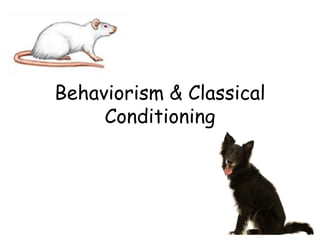Recommended
More Related Content
What's hot
What's hot (20)
Introductory Psychology: Learning Part II (Operant)

Introductory Psychology: Learning Part II (Operant)
Viewers also liked
Viewers also liked (6)
Systematic desensitisation Behaviourist treatment AS

Systematic desensitisation Behaviourist treatment AS
REFLECTION ON CONSUMER BEHAVIOR, METHODS OF RESEARCH AND PRODUCT MANAGEMENT

REFLECTION ON CONSUMER BEHAVIOR, METHODS OF RESEARCH AND PRODUCT MANAGEMENT
Similar to L&B wk 3
Similar to L&B wk 3 (20)
6LearningRevised by Pauline Davey Zeece, University of.docx

6LearningRevised by Pauline Davey Zeece, University of.docx
Classical Conditioning and Operant Conditioning.ppt

Classical Conditioning and Operant Conditioning.ppt
More from Cogpsychteacher
More from Cogpsychteacher (20)
Recently uploaded
APM Welcome
Tuesday 30 April 2024
APM North West Network Conference, Synergies Across Sectors
Presented by:
Professor Adam Boddison OBE, Chief Executive Officer, APM
Conference overview:
https://www.apm.org.uk/community/apm-north-west-branch-conference/
Content description:
APM welcome from CEO
The main conference objective was to promote the Project Management profession with interaction between project practitioners, APM Corporate members, current project management students, academia and all who have an interest in projects.APM Welcome, APM North West Network Conference, Synergies Across Sectors

APM Welcome, APM North West Network Conference, Synergies Across SectorsAssociation for Project Management
Recently uploaded (20)
This PowerPoint helps students to consider the concept of infinity.

This PowerPoint helps students to consider the concept of infinity.
Beyond the EU: DORA and NIS 2 Directive's Global Impact

Beyond the EU: DORA and NIS 2 Directive's Global Impact
APM Welcome, APM North West Network Conference, Synergies Across Sectors

APM Welcome, APM North West Network Conference, Synergies Across Sectors
Unit-V; Pricing (Pharma Marketing Management).pptx

Unit-V; Pricing (Pharma Marketing Management).pptx
Russian Escort Service in Delhi 11k Hotel Foreigner Russian Call Girls in Delhi

Russian Escort Service in Delhi 11k Hotel Foreigner Russian Call Girls in Delhi
Z Score,T Score, Percential Rank and Box Plot Graph

Z Score,T Score, Percential Rank and Box Plot Graph
ICT Role in 21st Century Education & its Challenges.pptx

ICT Role in 21st Century Education & its Challenges.pptx
L&B wk 3
- 1. Behaviorism & Classical Conditioning
- 2. Types of Learning Classical conditioning: learning to link two stimuli in a way that helps us anticipate an event to which we have a reaction Operant conditioning: changing behavior choices in response to consequences Cognitive learning: acquiring new behaviors and information through observation and information, rather than by direct experience
- 3. We come to associate repeated exposure to two stimuli occurring in sequence. Our natural response to one stimulus now can be triggered by the new, predictive stimulus. Associative Learning: Classical Conditioning Here, our response to thunder becomes associated with lightning. Stimulus 1: See lightning Stimulus 2: Hear thunder After Repetition Stimulus: See lightning Response: Cover ears to avoid sound
- 4. Associate “response” (behavior) with consequences. Associative Learning: Operant Conditioning
- 5. Behaviorism John B. Watson (1878-1958) classical conditioning B.F. Skinner (1904-1990) operant conditioning. Applications in shaping human behavior:
- 6. Cognitive Learning Cognitive learning occurs: 1.by observing events and the behavior of others. 2.by using language to acquire information about events experienced by others.
- 7. Ivan Pavlov’s Discovery Salivating in response to: just seeing the food. seeing the dish. seeing the person who brought the food. just hearing that person’s footsteps.
- 8. Before Conditioning No response Neutral stimulus (NS) Neutral stimulus: a stimulus which does not trigger a response
- 9. Unconditioned response (UR): dog salivates Unconditioned stimulus (US): yummy dog food Before Conditioning Unconditioned stimulus and response: a stimulus which triggers a response naturally, before/without any conditioning
- 10. Unconditioned response (UR): dog salivates Neutral stimulus (NS) Unconditioned stimulus (US) During Conditioning The bell/tone (N.S.) is repeatedly presented with the food (U.S.).
- 11. Conditioned response: dog salivates After Conditioning Conditioned (formerly neutral) stimulus The dog begins to salivate upon hearing the tone. The UR and the CR are the same response, triggered by different events. The NS and the CS are the same stimulus.
- 12. BELL SALIVATE? This is higher-order conditioning: turning a NS into a CS by associating it with another CS. Higher-Order Conditioning
- 13. 13 Acquisition What gets “acquired”? How can we tell that acquisition has occurred? Timing For the association to be acquired, the neutral stimulus (NS) needs to repeatedly appear right before the unconditioned stimulus (US). Acquisition refers to the initial stage of learning/conditioning.
- 14. Acquisition and Extinction Extinction refers to the diminishing of a conditioned response.
- 15. Spontaneous Recovery [Return of the CR] •After extinction, presenting the tone alone might lead to a spontaneous recovery
- 16. Behavioral Therapies Counterconditioning •Classical Conditioning 1.Aversive Conditioning 2.Systematic desensitization 3.Flooding
- 17. Aversion therapy for alcoholics Behavioral Therapies
- 18. Generalization vs. Discrimination Generalization refers to the tendency to have conditioned responses triggered by related stimuli. Discrimination refers to the learned ability to only respond to a specific stimuli, preventing generalization. MORE stuff makes you drool. LESS stuff makes you drool.
- 19. Insights about conditioning in general •It occurs in all creatures. •It is related to biological drives and responses. Insights about science •Learning can be studied objectively. Insights from specific applications •Substance abuse •triggers can be avoided or associated with new responses. Pavlov’s Legacy
- 20. Before Conditioning NS: rat No fear UCS: steel bar hit with hammer Natural reflex: fear Little Albert Experiment
- 21. During Conditioning NS: rat UCS: steel bar hit with hammer Natural reflex: fear Little Albert Experiment
- 22. After Conditioning NS: rat Conditioned reflex: fear Little Albert Experiment
